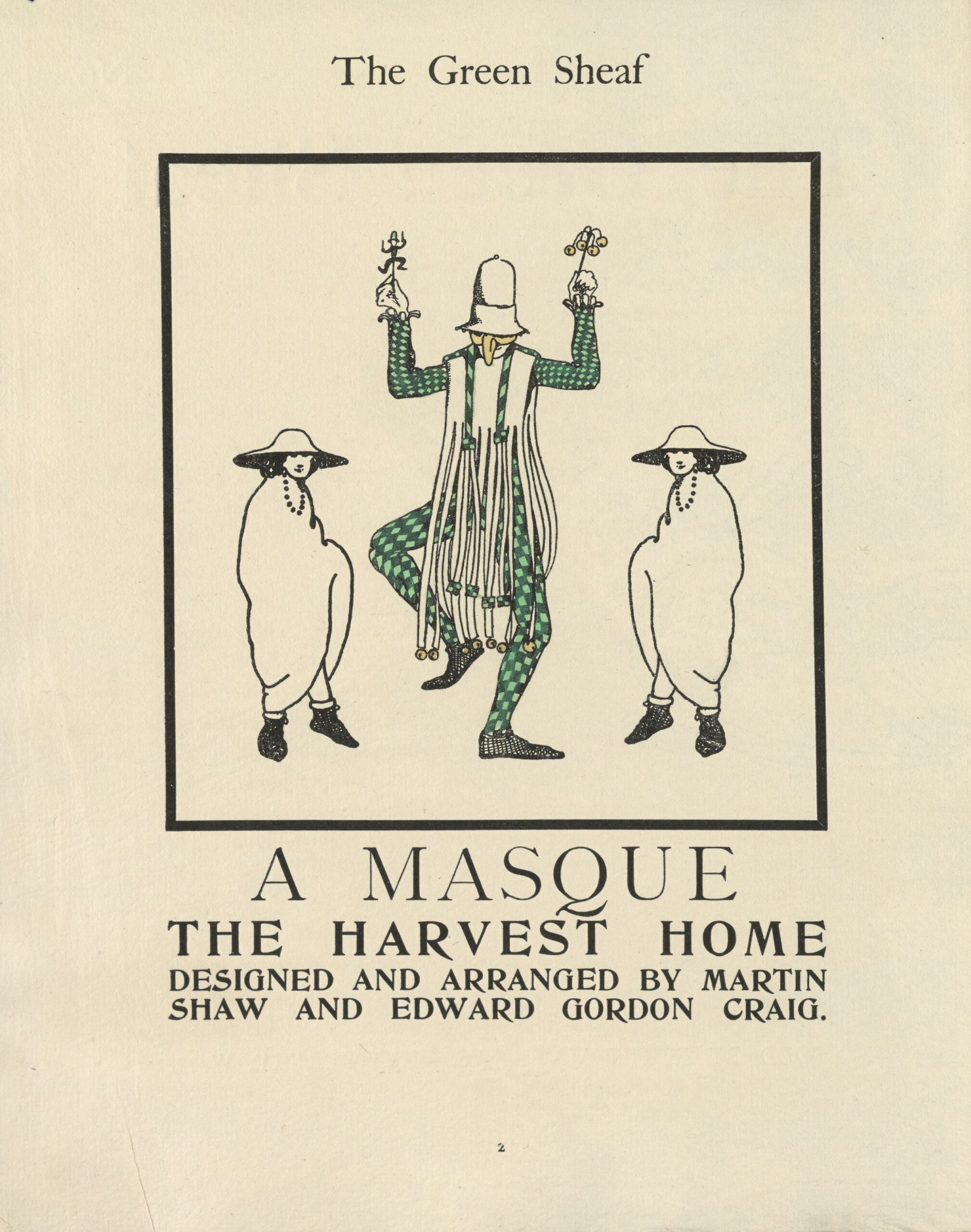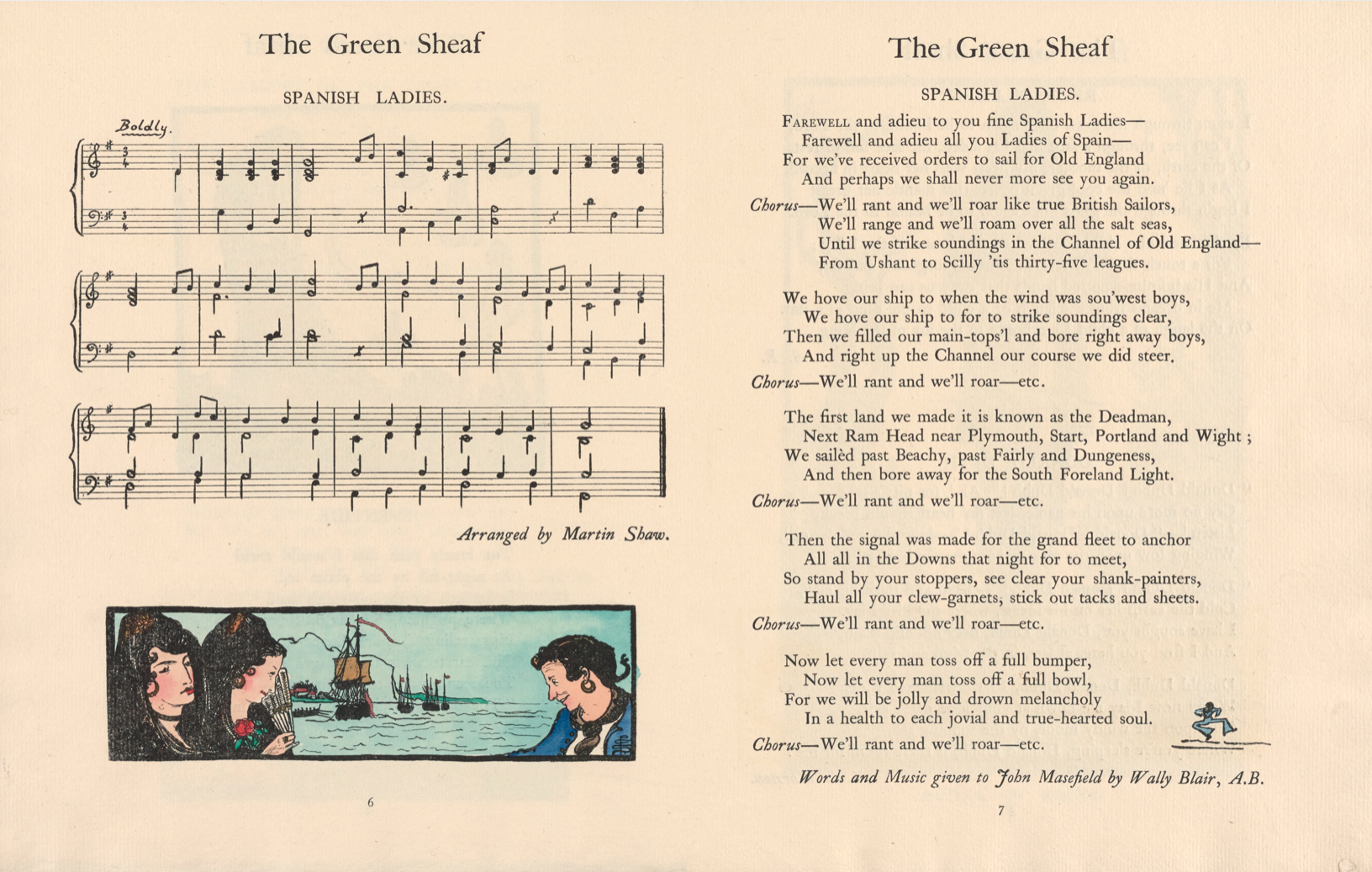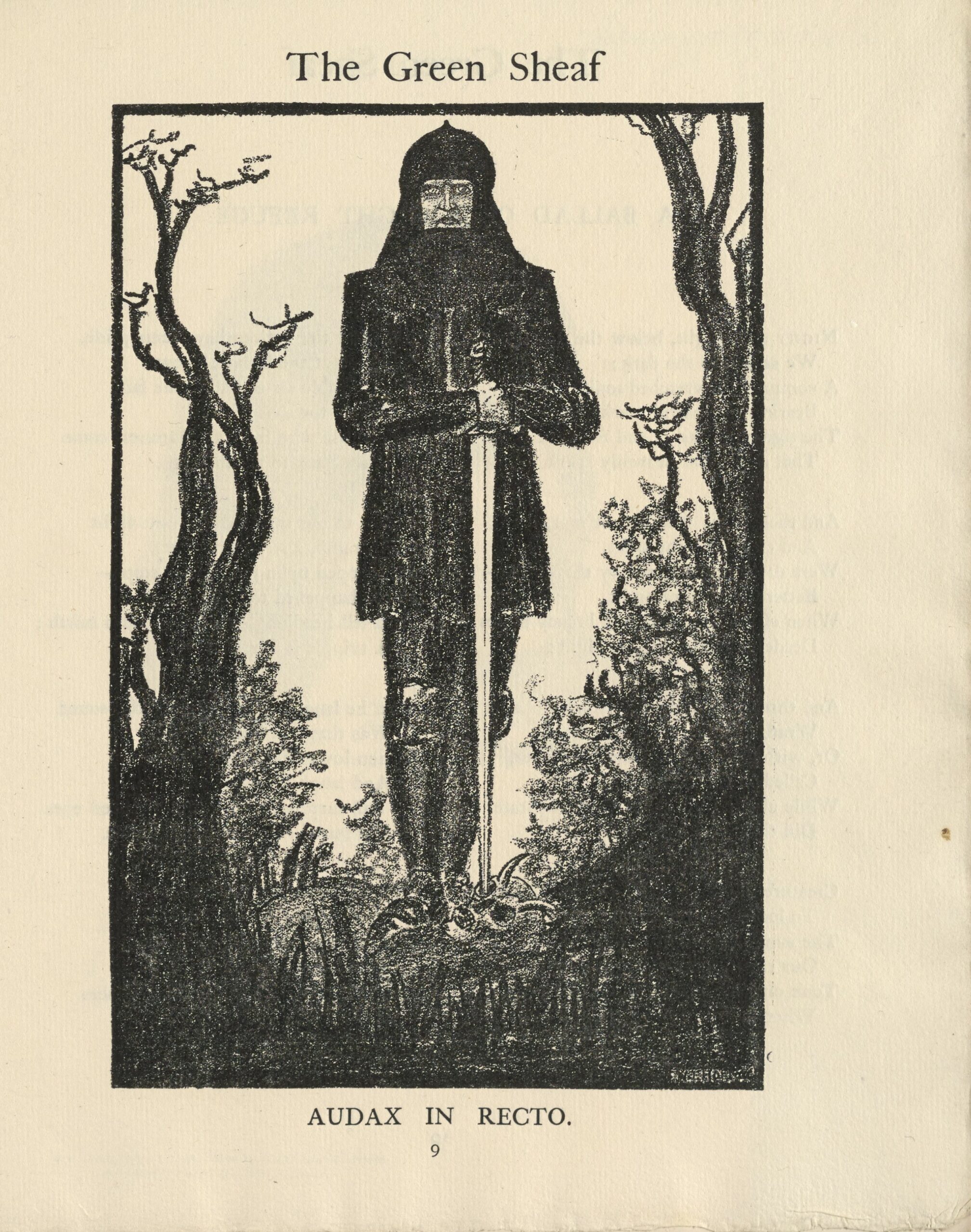XML PDF
Critical Introduction to The Green Sheaf
No. 3, 1903

When Pamela Colman Smith (1878-1951) brought out the third number of The Green Sheaf, its contents were more London-based than previous issues, with a performative theme reflecting the editor’s involvement with the newly formed Masquers Society. Originally named the “Theatre of Beauty” by W.B. Yeats (1865-1939), the short-lived Masquers aimed to revive a traditional performance practice by combining musical chanting and song with symbolic sets and historical costuming (Schuchard 434). Of the thirteen artists and authors connected with the third number, nearly half were members or associates of the Masquers, which held its meetings at the costume shop of Edith Craig (1869-1947) on Henrietta Street (Schuchard 434). In addition to Smith, these included Craig’s partner Christopher St. John (aka Christabel Marshall, 1871-1960) and brother Edward Gordon Craig (1872-1966), as well as poet Lina Marston (1866-?) and musician Martin Shaw (1875-1958). Highlighting the intersecting interests of print and performance in the little magazine community, a number of those who contributed to these periodicals were also interested in theatrical design; these include Walter Crane (1845-1915), T. Sturge Moore (1870-1944), Charles Ricketts (1866-1931), and Arthur Symons (1865-1945).
For Yeats and Smith, the aural and visual practices of the “New Art” of theatre promoted by the Masquers were closely associated with the ceremonial rituals and pageantry of the Hermetic Order of the Golden Dawn, the mystical order to which they both belonged (Schuchard 417). In May 1903, the month the first Green Sheaf issue appeared in print, Smith gave performances in “the art of ‘chanting’” at two of Yeats’s illustrated “Westminster” lectures on the New Art (Schuchard 436). While the orality of chanting could not be captured in The Green Sheaf’s printed pages, the magazine’s third number gestures toward the sense of sound by including sheet music and performative tropes. The visual influence of the Masquers is also evident throughout this “performance” issue. Notably, the chromatic values of the colour palette Smith uses for hand-colouring the number’s illustrations are more full-bodied and vigorous than the muted hues she had employed in the previous, dream-themed issue (fig.1).
The number opens with the brochure art and performance notes for A Masque: The Harvest Home, arranged by composer Martin Shaw and designed by theatrical designer E. Gordon Craig (2-3). Craig’s artwork features a Morris dancer wearing a green-checked suit, be-ribbonned vest, and large white hat over a mask with false nose (fig. 2). This central figure is dancing or jigging on one foot, holding up a stick with four golden bells in one hand and a small hand puppet in the other. On either side of the Morris dancer stands an androgynous figure wearing a wide-brimmed hat, a strand of beads, and black slippers; these may represent the harvesters in the pageant. Created for, but not produced by, the short-lived Purcell Operatic Society (1899-1902) founded by Shaw, The Harvest Home masque includes the baroque music of Henry Purcell (1659-1695) “for a charming country dance, and for the kissing duet,” as well as traditional English folk songs (Craig 3).

Pamela Colman Smith’s daily life in 1903 intermingled the business of publishing The Green Sheaf with her developing career as a performance artist. In addition to chanting demonstrations at Yeats’s illustrated lectures, Smith performed at his rooms at 18 Woburn Buildings and in her studio “at homes” in Chelsea. Her performances included her chanting rhythmically, reciting Yeats’s poetry, telling West Indian Annancy stories, and singing traditional folk songs. Arthur Ransome (1884-1967) recalled a visit to Smith’s studio in which everyone joined her in the singing of Spanish Ladies, “the best of all the songs that have ever come to London from the sea” (58). Smith’s inclusion of Martin Shaw’s musical score for this traditional tune, with lyrics “given to John Masefield” (1878-1967) by Able Seaman Wally Blair, makes good on The Green Sheaf manifesto’s promise to publish “tales of…the sea” and “ballads of the old world” (Advertisement for The Green Sheaf). Smith punctuates Shaw’s music with a tailpiece illustration showing two mantilla-draped women and a sailor in front of a boat harbour; on the facing page, she concludes Masefield’s lyrics with a tiny sailor dancing a hornpipe in the margin (fig. 3). The Green Sheaf introduces decorative textual ornaments in this third number, thereby increasing the beauty and harmony of Smith’s carefully arranged page openings (see Database of Ornament: Green Sheaf Collection).

In addition to the lyrics for Spanish Ladies, there are six poems in the third number of The Green Sheaf. E. Harcourt Williams (1880-1957), an actor, director, and producer in London and a colleague of Smith’s friends Ellen Terry (1847-1928) and Henry Irving (1838-1905), contributes the only fiction, the somewhat saccharine fairy tale of “Cornelion and Amethyst.” On the second page opening, Smith’s selections align the medieval past and the other-worldly present with “The Lament of the Dead Knight” by Alix Egerton (1870-1932) on the verso and “Eventide” by Ernest Radford (1857-1919) on the recto. Fellow Masquers Lina Marston and Christopher St. John contribute “Donald Dubh” and “A Ballad of a Night Refuge” respectively. While Marston’s dialogic ballad recalls traditional tales of the Clan Donald, St. John uses the ancient poetic form to engage with modern issues. Set in a contemporary urban centre’s homeless shelter, a madman briefly enchants “a company of wretched souls” with a vision of an egalitarian world, before being strait-jacketed and returned to the asylum by “four men, strong and sane” (10, 12). Dated Petersburg, 19— and dedicated to Russian political activist Maxim Gorky (1868-1936), St. John’s contribution is both performative and political. Editor Smith follows up “A Ballad of a Night Refuge” with “A Pagan Rhyme” by Irish Unionist Herbert Shaw (1885-1946). Like St. John’s ballad, Shaw’s poem is a city-centric piece celebrating the outsider, the oppressed, and the mad as individuals who can teach us to see the world differently. Smith places A.E.’s “Reconcilement,” extolling love and loyalty beyond the grave, on the same page as Marston’s “Donald Dubh,” with W. T. Horton’s drawing of an unflinching knight, “ Audax in Recto” (“Bold in the Right”—the Stewart Family Motto), on the facing page (fig. 4).

Unlike most visual material in The Green Sheaf, Horton’s drawings in the magazine appear in black and white; the single exception is his first contribution to the magazine, an illustration of William Blake (1757-1827) for the second number. In contrast, images by Cecil French (1879-1953) and Smith are almost always hand-coloured, whether they are full-page illustrations or small textual ornaments. One of the magazine’s most prolific contributors, French contributes almost as much visual material to the third issue as Smith herself does. French illustrates Egerton’s “The Lament of the Dead Knight” and Williams’s “Cornelion and Amethyst” with romantic, static pictures—a real contrast with the dynamic rhythms in the images Smith provides for Radford’s “Eventide,” Shaw’s “Spanish Ladies,” and St. John’s “Ballad.” As The Daily Mirror critic noted later that year when reviewing a joint exhibition of works by French and Smith at the Baillie Gallery, the latter’s “Dream Pictures” and “Waking Visions” had more appeal, if less technique, “because she makes us feel her own sincerity.” In French’s drawings, both labour and influence were, according to this critic, all too evident (“The Galleries and Ateliers”). The most significant visual material in the third number, however, is not a hand-coloured illustration, but rather the pictorial supplement: a reproduction on art paper of a drawing of Mrs. Stirling made in 1858 by Pre-Raphaelite artist Dante Gabriel Rossetti (1828-1882). Its inclusion in The Green Sheaf highlights the Pre-Raphaelite roots of Pamela Colman Smith’s art while also paying homage to the origins of the little magazine as a genre in The Germ (1850), the short-lived but influential Pre-Raphaelite periodical of art and literature.
The third number of The Green Sheaf concludes with two pages of advertisements promoting Smith’s professional network, including Edith Craig’s Costume Shop and Rosa Baillie’s (dates unknown) lace-making services at the gallery run by her brother John (1866-1926) in London. One of the new titles in the publishing list advertised by Elkin Mathews (1851-1921) is The Canon: An Exposition of the Pagan Mystery Perpetuated in the Cabala as the Rule of all the Arts —a book whose mystic subject matter aligns closely with Smith’s interests at this time (Advertisements). Overall, the performance-themed issue of The Green Sheaf is as richly diverse in contents as it is high in quality.
©2022 Lorraine Janzen Kooistra, FRSC, Emerita Professor of English and Senior Research Fellow, Centre for Digital Humanities, Toronto Metropolitan University
Works Cited
- Advertisements. The Green Sheaf, No. 3, 1903, pp. 15-16. Green Sheaf Digital Edition, edited by Lorraine Janzen Kooistra, Yellow Nineties 2.0, Toronto Metropolitan University Centre for Digital Humanities, 2022. https://1890s.ca/GSV3-ads/
- A.E. “Reconcilement.” The Green Sheaf, No. 3, 1903, p. 8. Green Sheaf Digital Edition, edited by Lorraine Janzen Kooistra, Yellow Nineties 2.0, Toronto Metropolitan University Centre for Digital Humanities, 2022. https://1890s.ca/GSV3-ae-reconcilement/
- Craig, Edward Gordon. “A Masque: The Harvest Home,” The Green Sheaf, No. 3, 1903, pp. 2-3. Green Sheaf Digital Edition, edited by Lorraine Janzen Kooistra, Yellow Nineties 2.0, Toronto Metropolitan University Centre for Digital Humanities, 2022. https://1890s.ca/GSV3-craig-harvest/
- —. Illustration for “A Masque: The Harvest Home,” by Edward Gordon Craig. The Green Sheaf, No. 3, 1903, p. 2. Green Sheaf Digital Edition, edited by Lorraine Janzen Kooistra, Yellow Nineties 2.0, Toronto Metropolitan University Centre for Digital Humanities, 2022. https://1890s.ca/GSV3-craig-masque/
- Egerton, Alix. “The Lament of the Dead Knight,” illustrated by Cecil French. The Green Sheaf, No. 3, 1903, p. 4. Green Sheaf Digital Edition, edited by Lorraine Janzen Kooistra, Yellow Nineties 2.0, Toronto Metropolitan University Centre for Digital Humanities, 2022. https://1890s.ca/GSV3-egerton-lament/
- French, Cecil. Illustration for “Cornelion and Amethyst,” by E. Harcourt Williams. The Green Sheaf, No. 3, 1903, p. 14. Green Sheaf Digital Edition, edited by Lorraine Janzen Kooistra, Yellow Nineties 2.0, Toronto Metropolitan University Centre for Digital Humanities, 2022. https://1890s.ca/GSV3-french-cornelion/
- —. Illustration for “The Lament of the Dead Knight,” by Alix Egerton. The Green Sheaf, No. 3, 1903, p. 4. Green Sheaf Digital Edition, edited by Lorraine Janzen Kooistra, Yellow Nineties 2.0, Toronto Metropolitan University Centre for Digital Humanities, 2022. https://1890s.ca/GSV3-french-lament/
- “The Galleries and Ateliers.” The Daily Mirror, 18 November 1903, p. 6.
- Horton, W. T. “Audax in Recto.” The Green Sheaf, No. 3, 1903, p. 9. Green Sheaf Digital Edition, edited by Lorraine Janzen Kooistra, Yellow Nineties 2.0, Toronto Metropolitan University Centre for Digital Humanities, 2022. https://1890s.ca/GSV3-horton-audax/
- —. Illustration for Untitled [“The World of Imagination”], by William Blake. The Green Sheaf, No. 2, 1903, p. 2. Green Sheaf Digital Edition, edited by Lorraine Janzen Kooistra, Yellow Nineties 2.0, Toronto Metropolitan University Centre for Digital Humanities, 2022. [url]
- Marston, Lina. “Donald Dubh,” decorated by Pamela Colman Smith. The Green Sheaf, No. 3, 1903, p. 8. Green Sheaf Digital Edition, edited by Lorraine Janzen Kooistra, Yellow Nineties 2.0, Toronto Metropolitan University Centre for Digital Humanities, 2022. https://1890s.ca/GSV3-marston-donald/
- Masefield, John, adapted. “Spanish Ladies” (lyrics). The Green Sheaf, No. 3, 1903, p. 7. Green Sheaf Digital Edition, edited by Lorraine Janzen Kooistra, Yellow Nineties 2.0, Toronto Metropolitan University Centre for Digital Humanities, 2022. https://1890s.ca/GSV3-blair-spanish-ladies/
- Radford, Ernest. “Eventide,” illustrated by Pamela Colman Smith. The Green Sheaf, No. 3, 1903, p. 5. Green Sheaf Digital Edition, edited by Lorraine Janzen Kooistra, Yellow Nineties 2.0, Toronto Metropolitan University Centre for Digital Humanities, 2022. https://1890s.ca/GSV3-radford-eventide/
- Ransome, Arthur. Bohemia in London (1912). Reprinted by Forgotten Books, 2015.
- Rossetti, Dante Gabriel. “Mrs. Stirling.” Original drawing (Nov. 1858), reproduced by Goodwin. Illustrative Supplement (np) to The Green Sheaf, No. 3, 1903. Green Sheaf Digital Edition, edited by Lorraine Janzen Kooistra, Yellow Nineties 2.0, Toronto Metropolitan University Centre for Digital Humanities, 2022. https://1890s.ca/GSV3-supplement/
- Schuchard, Ronald. “W.B. Yeats and the London Theatre Societies, 1901-1904.” Review of English Studies, n.s., vol. 29, no. 116, November 1978, pp. 415-446.
- Shaw, Herbert. “A Pagan Rhyme,” The Green Sheaf, No. 3, 1903, p 12. Green Sheaf Digital Edition, edited by Lorraine Janzen Kooistra, Yellow Nineties 2.0, Toronto Metropolitan University Centre for Digital Humanities, 2022 https://1890s.ca/GSV3-shaw-pagan-rhyme/
- Shaw, Martin, arr. “Spanish Ladies” (musical score), illustrated by Pamela Colman Smith. The Green Sheaf, No. 3, 1903, p 6. Green Sheaf Digital Edition, edited by Lorraine Janzen Kooistra, Yellow Nineties 2.0, Toronto Metropolitan University Centre for Digital Humanities, 2022. https://1890s.ca/GSV3-shaw-spanish-ladies/
- Smith, Pamela Colman. Illustration for “Spanish Ladies,” arranged by Martin Shaw. The Green Sheaf, No. 3, 1903, p. 6. Green Sheaf Digital Edition, edited by Lorraine Janzen Kooistra, Yellow Nineties 2.0, Toronto Metropolitan University Centre for Digital Humanities, 2022. https://1890s.ca/GSV3-smith-spanish-ladies/
- —. Illustration for “A Ballad of a Night Refuge,” by Christopher St. John. The Green Sheaf, No. 3, 1903, p. 12. Green Sheaf Digital Edition, edited by Lorraine Janzen Kooistra, Yellow Nineties 2.0, Toronto Metropolitan University Centre for Digital Humanities, 2022. https://1890s.ca/GSV3-smith-silhouettes/
- St. John, Christopher. “A Ballad of a Night Refuge,” illustrated by Pamela Colman Smith. The Green Sheaf, No. 3, 1903, pp. 10-12. Green Sheaf Digital Edition, edited by Lorraine Janzen Kooistra, Yellow Nineties 2.0, Toronto Metropolitan University Centre for Digital Humanities, 2022. https://1890s.ca/GSV3-st-john-ballad/
- Williams, E. Harcourt. “Cornelion and Amethyst,” illustrated by Cecil French. The Green Sheaf, No. 3, 1903, pp. 13-14. Green Sheaf Digital Edition, edited by Lorraine Janzen Kooistra, Yellow Nineties 2.0, Toronto Metropolitan University Centre for Digital Humanities, 2022. https://1890s.ca/GSV3-williams-cornelion/
MLA citation: Kooistra, Lorraine Janzen. “Critical Introduction to The Green Sheaf No. 3, 1903.” Green Sheaf Digital Edition, Yellow Nineties 2.0, edited by
Lorraine Janzen Kooistra, Toronto Metropolitan University Centre for Digital Humanities,
2023. https://1890s.ca/gsv3_introduction/.
